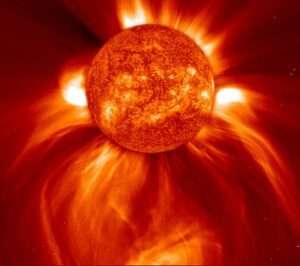The sun, our nearest star, plays a vital role in sustaining life on Earth. It goes through cycles of activity, with one such cycle known as the solar maximum. Recently, scientists have predicted that the sun will reach its next solar maximum in approximately two years. While this event may sound intriguing, it could potentially have significant impacts on our daily lives, particularly on global internet connectivity. In this article, we will explore the concept of the solar maximum, its potential consequences, and how it could lead to an “Internet Apocalypse.”

The sun is about to reach its solar maximum in 2025. This is the point in the sun’s 11-year cycle when it is most active. During solar maximum, the sun produces more sunspots, solar flares, and coronal mass ejections (CMEs). These events can have a significant impact on the Earth’s atmosphere and on our technology.
Understanding the Solar Maximum
The solar maximum is a phase in the solar cycle when the sun experiences the highest level of activity. This activity is characterized by an increase in the number of sunspots, solar flares, and coronal mass ejections (CMEs). These phenomena are the result of intense magnetic activity on the sun’s surface.
The solar cycle follows an approximately 11-year pattern, with periods of high activity (solar maximum) and low activity (solar minimum). During the solar maximum, the sun’s magnetic field becomes highly chaotic, leading to an increased likelihood of solar flares and CMEs. These solar storms can release a tremendous amount of energy and have the potential to impact various technological systems on Earth.
The Threat to Global Internet Connectivity
One of the potential consequences of a solar maximum is the disruption of global internet connectivity. The main reason for this lies in the vulnerability of satellites and communication infrastructure to solar storms. Satellites play a crucial role in transmitting signals for internet connectivity, telecommunication services, and various other applications. However, during a solar maximum, solar flares and CMEs can release a significant amount of charged particles and electromagnetic radiation towards Earth.
When these charged particles interact with the Earth’s magnetic field, they can induce powerful currents in long conductors such as power lines and communication cables. These induced currents have the potential to damage or even destroy critical components of satellite systems and communication infrastructure. The result could be widespread interruptions in internet connectivity, leading to an “Internet Apocalypse” scenario.
Mitigating the Potential Impact
While the potential impact of a solar maximum on global internet connectivity is a cause for concern, scientists and engineers are actively working on strategies to mitigate the risks. One approach is to develop advanced warning systems that can detect solar flares and CMEs with greater accuracy and provide timely alerts to satellite operators and telecommunication companies. These alerts would enable them to take necessary precautions to safeguard their systems and minimize potential disruptions.
Another approach is to enhance the resilience of satellites and communication infrastructure to withstand the effects of solar storms. This involves designing and implementing robust shielding mechanisms, backup systems, and redundancy measures to ensure the continuity of essential services even in the face of severe space weather events.
Furthermore, international collaborations and information-sharing initiatives are being fostered to facilitate coordinated responses and preparedness strategies among different countries and organizations. By working together, scientists, engineers, and policymakers can collectively address the challenges posed by the solar maximum and ensure the reliability and resilience of global internet connectivity.
How solar maximum can affect the internet:
- Sunspots: Sunspots are dark patches on the sun’s surface. They are caused by magnetic activity, and they can disrupt radio communications and GPS signals. During solar maximum, there are more sunspots, so there is a greater risk of these disruptions.
- Solar flares: Solar flares are sudden bursts of energy from the sun. They can emit high-energy particles that can damage satellites and disrupt power grids. During solar maximum, there are more solar flares, so there is a greater risk of these disruptions.
- CMEs: CMEs are large expulsions of plasma from the sun’s corona. They can travel at speeds of up to 1 million miles per hour. When a CME hits the Earth’s atmosphere, it can cause a geomagnetic storm. Geomagnetic storms can disrupt power grids, radio communications, and GPS signals.
What can be done to mitigate the impact of solar maximum on the internet?
- Space weather forecasting: Scientists are working to improve space weather forecasting. This will help us to predict when solar events are likely to occur, so that we can take steps to mitigate their impact.
- Satellite hardening: Satellites can be hardened to withstand the effects of solar events. This involves using materials that are less susceptible to damage from high-energy particles.
- Backup power: Power grids can be equipped with backup power supplies to keep them running during a geomagnetic storm.
- Contingency plans: Businesses and governments should have contingency plans in place in case of a solar event that disrupts the internet.
The solar maximum is a natural event, but it can have a significant impact on our technology. By taking steps to mitigate the impact of solar maximum, we can help to protect the internet and ensure that it remains available during this time.The sun’s impending solar maximum is a natural phenomenon that occurs as part of its regular cycle of activity. While it holds great scientific interest, it also presents potential risks to global internet connectivity. The disruption of satellites and communication infrastructure due to solar storms can lead to widespread interruptions in internet services, impacting our daily lives and various sectors of the economy. However, through advanced warning systems, improved resilience measures, and international collaborations, we can mitigate these risks and ensure the continuity of essential services even during periods of heightened solar activity. As we approach the next solar maximum, it is crucial to remain vigilant and proactive in safeguarding our technological systems to prevent an “Internet Apocalypse.”
